| Birding & Wildlife Holidays |
History of Sri Lanka
Establishment of one of the greatest civilizations in the world
Ratnadvipa or the land of gems, now Sri Lanka has an impressive history, which dates back to late 6th century B.C, when Indo- Aryans arrived and established the first human settlements. But the pre- history goes much more long backwards as evidenced by the presence of ‘Yakkha’ & ‘Naga’ tribes. The Aryans who landed ‘Tammanna’ in the North- western coast, named the island ‘Thambapanni’ caused by their palms being changed to bronze colour, upon touching the sand.
These Aryans, who were from northern India expanded inland along Malwathu river towards Anuradhapura of north central province of Sri Lanka. Wijaya, who is the first ruler according to the written history as well as his successors were ruling from local cities, before Anuradhapura was declared official capital. In 4th century B.C a rebel prince captured the throne and became the first Sri Lankan King for whole nation. He, who enthroned as Pandukabhaya made Anuradhapura the capital of Sri Lanka, which made the path to a Glorious Kingdom.
Hereafter administration and irrigation works developed leading to a stable civilization. In the same time Greek merchants, who visited Sri Lanka and called it ‘Tabrobane’ appreciated the features and functions of this Kingdom including international trade. Buddhism was introduced to Sri Lanka in 3rd century B.C, during the reign of King Devanampiya 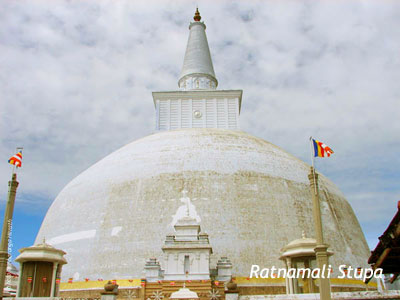 Tissa, who had close relationship of Mauryan King Dharmashoka. Buddhism here onwards nurtured Sri Lankan culture ahead leading to the formation of unique architecture, art and society. At the same time Auradhapura city was declared as the ‘Sacred City’, encouraging constructions of large monuments dedicated to Buddhism.
Tissa, who had close relationship of Mauryan King Dharmashoka. Buddhism here onwards nurtured Sri Lankan culture ahead leading to the formation of unique architecture, art and society. At the same time Auradhapura city was declared as the ‘Sacred City’, encouraging constructions of large monuments dedicated to Buddhism.
After the establishment of Anuradhapaura kingdom many South Indian invasions took place and continued throughout the history. Sometime after the great reign of Devanampiya Tissa, Elara, who came from Chola seized Anuradhapura Kingdom. In 161 B.C warrior King Duthagamini won the single combat against Tamil King Elara and brought victory for Sri Lanka. But he ordered public to respect the memorial, which was builtt on behalf of Elara, who said to be a great personality. King Duthagamini is a national hero and one of the greatest builders of the nation who marks a golden era of the History. Great Ratnamali Stupa is one of many of his era ’s buildings, which was second only to the two giant pyramids in Giza.
Caused by the continuation of South Indian Invasions, in order to 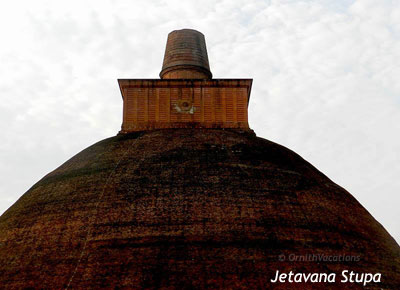 preserve Buddhism, Buddhist doctrines, which had been transferring orally were written down for the first time during the reign of Valagambha in 89-77 B.C. This was an influential move in the progress of History.
preserve Buddhism, Buddhist doctrines, which had been transferring orally were written down for the first time during the reign of Valagambha in 89-77 B.C. This was an influential move in the progress of History.
With the progress of this Buddhism based civilization massive irrigation works and monuments with unique architecture continued. Since the Sinhalese Kingdom was spread-out in dry zone of the island, storage of rain water was a must. Hence the construction of giant tanks took place. Pipe water was also introduced to the capital in 1st century A.D. Abhayagiri Stupa built during Valagambha’s reign and the Gigantic Jetavana Stupa by Mahasen- the great builder are noteworthy giants, both of which rose taller than Ratnamali stupa. Jetavana the largest of this kind, is the largest ever brick building in the world !
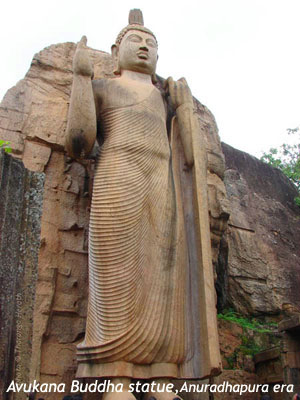
In 5th century A.C one of the world’s greatest historical monuments was built in Sigiriya- the Rock Fortress. King Kashyapa, during whose reign, this grand castle was built to survive himself from his brother, who was the legitative heir to the throne, and who finally defeated Kashyapa. 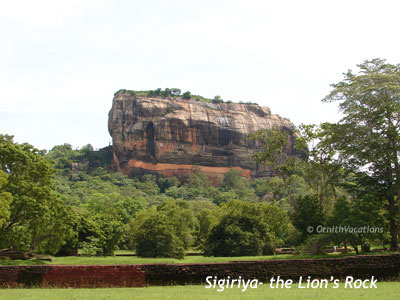
Anuradhapura grand kingdom after several other centuries of its glory suffered from distructive invasions from South India, during an era of some weak rulers. Finally in 10th century South Indian Chola invaders conquered the Anuradhapura kingdom and burnt whole capital taking all the treasures of Lanka. They abandoned the city and made Polonnarauwa, located south east of Anuradhapura, the Capital.
Then another Sinhalese warrior prince emerged from South, called ‘Kiththi’ oraganized the armies from Ruhuna and invaded Polonnaruwa and defeated the Cholas and brought the independence back to Sri Lanka. He enthroned as Wijayabahu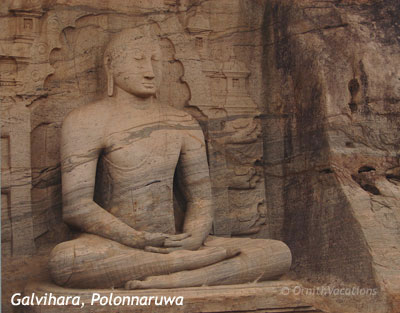 I and established Polonnaruwa Kingdom. After his reign Parakramabahu the Great who came to the throne renovated destroyed great monuments in Anuradhapura and is responsible for a vast number of irrigation works making the Kingdom affluent followed by the great works of other great ruler Nissankamalla. Once again after the reigns of these great rulers Polonnaruwa kindom was also suffered by south Indian Invders and this time by the ‘demon’ destroyer Magha of Kalinga, who burnt and destroyed not only Polonnaruwa but the whole civilization. Then the srilankan kingdoms shifted towards south being unified by Sri Lankan heroes time to time towards the last kingdom of Kandy.
I and established Polonnaruwa Kingdom. After his reign Parakramabahu the Great who came to the throne renovated destroyed great monuments in Anuradhapura and is responsible for a vast number of irrigation works making the Kingdom affluent followed by the great works of other great ruler Nissankamalla. Once again after the reigns of these great rulers Polonnaruwa kindom was also suffered by south Indian Invders and this time by the ‘demon’ destroyer Magha of Kalinga, who burnt and destroyed not only Polonnaruwa but the whole civilization. Then the srilankan kingdoms shifted towards south being unified by Sri Lankan heroes time to time towards the last kingdom of Kandy.
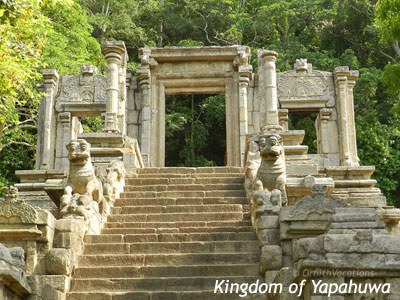
European invasions
In the later era of Sri Lankan history 3 european invaders Portuguese, Dutch and British consecutively tried to conquer Sinhalese Kingdom. Portuguese as the first European invaders arrived the island in early 16th century leading to devastation by wars for over a century. After several defeats in battles, Portuguese had to drop their final hope of Kandy, then capital of Sri Lanka, upon severe devastations suffered at the battle at Gannoruwa under the powerful Kingship of Rajasinghe II. This king negotiated with the Dutch, who were sailing and trading in the region that time, to drive away the Portuguese who gave up completely leaving Colombo to the Dutch in 1656.
Then the Dutch occupied the maritime provinces of Sri Lanka, trading spices and others for about one and half century. 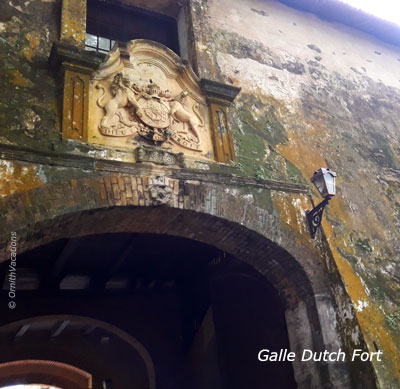 Meanwhile in Kandyan kingdom, after the strong leadership of Rajasinghe II, the Sinhalese dynasty started to collapse which finally Nayakkar Dynasty of South India was transferred the kingship after 1739. But some powerful Sinhalese chieftains were against Nayakkar leadership and were trying to get Sinhalese dynasty back to throne. At the same time British were keeping an eye on this dispute of the Kandy Kingdom, who were expanding their dominion in Indian Ocean region. Subsequently the British started to conquer the Kandyan kingdom with the assistance of sinhalese chieftants and seized it in 1815. Thereafter British were ruling Ceylon- the name given by them to Sri Lanka, till 1948, when Sri Lanka became independant from the British crown.
Meanwhile in Kandyan kingdom, after the strong leadership of Rajasinghe II, the Sinhalese dynasty started to collapse which finally Nayakkar Dynasty of South India was transferred the kingship after 1739. But some powerful Sinhalese chieftains were against Nayakkar leadership and were trying to get Sinhalese dynasty back to throne. At the same time British were keeping an eye on this dispute of the Kandy Kingdom, who were expanding their dominion in Indian Ocean region. Subsequently the British started to conquer the Kandyan kingdom with the assistance of sinhalese chieftants and seized it in 1815. Thereafter British were ruling Ceylon- the name given by them to Sri Lanka, till 1948, when Sri Lanka became independant from the British crown.
Present Administration
In 1972 constitution Sri Lanka became a republic and it’s English name ‘Ceylon’ was also changed to 'Sri Lanka'. The present administration system of the Democratic Socialist Republic of Sri Lanka was adopted under the constitution of 1978 upon the establishment of the parliament, with a Prime Minister and a cabinet. The executive President was made the head of the nation.
| Go Back |
|---|
| Back to Top |
|---|
Copyright © Ornithvacations. All Rights Reserved 2021.